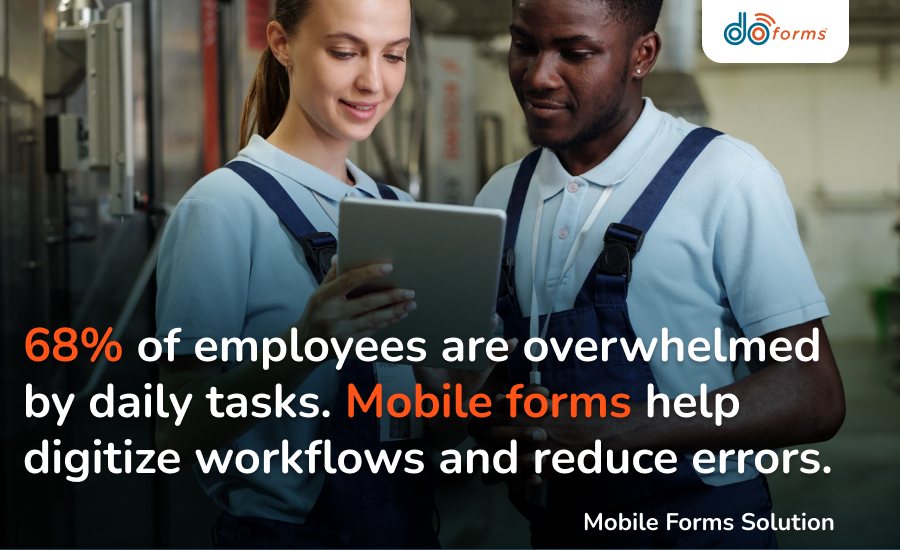
40% of caregivers say they experience high-burden situations when spending many hours providing care, while 38% describe their day-to-day work as highly stressful.
A caregiver daily checklist can help reduce the stress associated with caregiving by providing a structured approach to caregiving tasks, streamlining the process and facilitating communication with healthcare providers.
We’ll share 50 items that your caregiver daily checklist should include, plus explain how ditching the paperwork and going digital will further help streamline your job and ultimately allow you to provide better care.
Digitalize your checklists with doForms.
Try doForms for free!
Table of Contents
What Is A Caregiver Daily Checklist?
A caregiver daily checklist is a document that lists all of the services a caregiver should provide to a person who needs daily monitored care, whether due to age, disability or illness.
This checklist contains a set of physical, psychological and emotional assistance tasks a caregiver should provide to ensure that the needs of the patient are met each day.
Caregiver daily checklists are most often used in:
- Nursing homes
- Adult daycare centers
- Home health care
- Assisted living facilities
- Hospitals
- Hospice centers
These checklists typically include details about:
- Health monitoring
- Medication management
- Personal care
- Meal planning and preparation
- Hydration
- Mobility and exercise
- Emotional support
- Specialized care
Types Of Caregiver Daily Checklists
The type of caregiver checklist used depends on the age and condition of the patient who requires care.
The most common types of caregiver checklists include:
- Elderly caregiver daily checklist: This checklist focuses on providing care and support to elderly individuals. It typically includes tasks related to medication management, mobility and emotional well-being assistance.
- Pediatric caregiver checklist: This checklist is tailored to caring for children and typically includes tasks such as feeding, changing diapers, administering pediatric medications and assisting with developmental activities.
- Alzheimer’s and dementia caregiver checklist: This checklist is designed for caregivers who provide care to those with Alzheimer’s disease or dementia. It typically focuses on safety measures, cognitive stimulation and communication strategies.
- Post-surgery caregiver checklist: This checklist is used for patients who are recovering from surgery. It typically includes wound care, medication management, mobility exercises and monitoring for post-operative complications.
- Hospice caregiver checklist: This checklist focuses on providing compassionate end-of-life care and typically addresses pain management, emotional support and communication with both the patient and their family.
- Respite caregiver checklist: This checklist is designed for respite caregivers who temporarily relieve primary caregivers, ensuring the patient’s safety, comfort and well-being during the respite period.
Paper vs. Digital Caregiver Checklists
While paper checklists are unorganized and easily damaged or misplaced, digital checklists offer lasting organization, security and improved communication across teams.
The benefits of using electronic caregiver checklists include:
Efficient task management: Unlike paper caregiver checklists, which can be challenging to manage and track, digital solutions offer features that can help with task management. For example, the doForms mobile forms solution allows you to set reminders, which can help you track medical appointments and monitor medication schedules.
Accessibility: Unlike paper caregiver checklists, which can be easily damaged or lost, digital caregiver checklists are accessible from various devices at any time, for those with approved access. For example, forms can easily be shared with the click of a button, to new caregivers who need patient information or healthcare providers who can compare a patient’s daily vitals to the records from their head-to-toe assessment checklist or annual physical exam checklist.
Customization: Compared to paper checklists, which often come in fixed formats, digital caregiver checklists can be customized to the unique needs of each patient. Checklists can be edited to include exact medication dosage, notes about potential side effects, activities the patient enjoys and other helpful notes.
Remote monitoring: Unlike paper checklists, digital caregiver checklists can be shared with healthcare professionals to remotely monitor care activities in real-time, ensuring that all patients receive proper care and support. For example, if there are concerning changes in the vital signs, the caregiver can share the checklist with a doctor, who can adjust the medical care plan.

A digital caregiver daily checklist can help improve task management and offers accessibility from any location or mobile device
50 Items To Include In Your Caregiver Duty Checklist
Caregiver checklists can be tailored to each patient with customizable mobile forms. For a general daily checklist, find 50 essential items below.
Medical Care
- Check vital signs
- Schedule regular physical exams and other medical appointments
- Remind the patient to take medications
- Pick up prescriptions
- Check blood sugar and blood pressure
- Monitor for fatigue, mood changes and heat sensitivity symptoms
Personal Care
- Bathe or shower
- Wash hair
- Comb hair
- Brush teeth
- Shave
- Trim nails
- Apply skin care routine
- Help with getting dressed
- Help address heat sensitivity (prepare cooling scarves, washcloths or cold packs, etc.)
- Help address incontinence (prepare underwear, feminine pads, absorbent sheets, extra clothes or towels)
Nutrition
- Shop for groceries
- Prepare meals
- Help with feeding
- Encourage /Restrict fluids
- Remind the patient to take vitamins
- Organize pantry and fridge
Toileting
- Assist with going to bathroom
- Assist with bedpan/urinal
- Perform incontinence care
- Empty urinary drainage/catheter bag
- Empty colostomy bag
Mobility
- Assist with walking
- Turn position in bed (for bedridden care patients)
- Help the patient move from/to bed or wheelchair (for wheelchair-bound care patients)
- Assist with home exercises
Companionship
- Accompany on a walk
- Accompany to appointments
- Coordinate community outings
- Read aloud
- Watch videos together
- Engage in playing games
Household Services
- Wash laundry
- Clean rooms
- Take out trash
- Control room temperature
- Check for oxygen on/off
- Make bed
- Change sheets
- Pick up mail
- Pay the bills
Social & Outside Activities
- Set up family visits
- Organize trips to nearby towns or places of interest
- Encourage and organize meetings with friends
- Enroll in educational or learning activities, such as cooking, crafts, painting or photography lessons
Keep in mind that according to some state regulations, caregivers are not allowed to assist with any elements of catheter or colostomy care.
When creating your own caregiver daily checklist, make sure it complies with your local health regulations, along with your caregiver organization’s policies.

From medical and personal care to household support and companionship, a caregiver
daily checklist helps you handle your duties with accuracy and compassion
Factors To Consider For A Caregiver Checklist
Ready to create your daily caregiver checklist? Consider the notes below regarding your patient, legal guidelines and more.
- Learn about the patient’s condition: Tailor the checklist to the specific needs and routines of the patient, to make sure they receive personalized care and feel comfortable. Talk to their healthcare providers about their specific care needs and any chronic illnesses or disabilities, to include relevant medical tasks in your checklist.
- Explore individual needs and preferences: Become familiar with the patient’s specific needs and preferences regarding meals, laundry, shopping and bathing. Respect cultural and religious beliefs, dietary restrictions and practices that are important to the patient.
- Plan for emergencies: Add a plan for responding to emergency situations, such as an emergency contact, the location emergency supplies are located and steps to take.
- Organize important information: Write down the names, addresses and phone numbers of the patient’s doctors and family members, along with all medications and dosages. Organize their financial information like bills, bank accounts and insurance policies. Photocopy their social security card, insurance cards and other important personal information.
- Legal and privacy compliance: Make sure your caregiver checklist adheres to all relevant legal and privacy regulations, such as the Health Insurance Portability and Accountability Act (HIPAA). If using digital checklists, make sure the platform is secure and accessible only to authorized users, to protect patient privacy.
Ready to give digital checklists a shot?
Try doForms for free!
How To Create a Caregiver Daily Checklist Template With doForms
As a leading mobile forms solution used across industries, doForms can be an invaluable assistant in a challenging caregiver routine.
With doForms, you can easily create caregiver duty checklists for each patient, tailoring the form to the patient’s specific condition, medical needs, personal needs and preferred activities.
Our pre-made templates and over 30 drag-and-drop functionalities give you the flexibility to build versatile caregiver checklists or compile your own checklists from scratch.
You can easily create and access your checklists with a smartphone or tablet on the go, whether at a patient’s home, a hospital or an assisted living facility.
doForms also allows you to view, edit and share checklists within your organization in real-time, which allows you to seek a professional opinion and recommendations from the appropriate healthcare providers if your patient’s condition changes.
Check out the video below to learn more about the features and capabilities doForms offers.
provider: youtube
url: https://www.youtube.com/watch?v=vBVPnnUtR5c&feature=youtu.be
src: https://www.youtube-nocookie.com/embed/vBVPnnUtR5c?wmode=transparent&rel=0&feature=oembed
src mod: https://www.youtube-nocookie.com/embed/vBVPnnUtR5c?wmode=transparent&rel=0
src gen: https://www.youtube-nocookie.com/embed/vBVPnnUtR5c
Along with customizable mobile forms that allow you to cut costs and streamline operations, doForms helps you improve quality of care, by giving you instant access to your patients’ health information when and where you need it.
Manage patient visits with the integrated scheduling system, track employee locations while on-site with GPS functionality, and take the added stress out of caregiving with a simplified documentation system.
Switch to doForms today.




